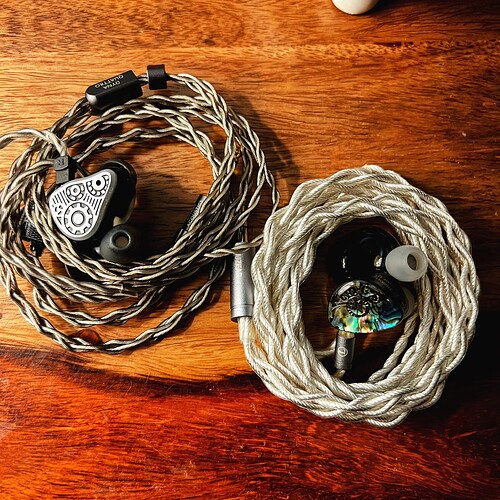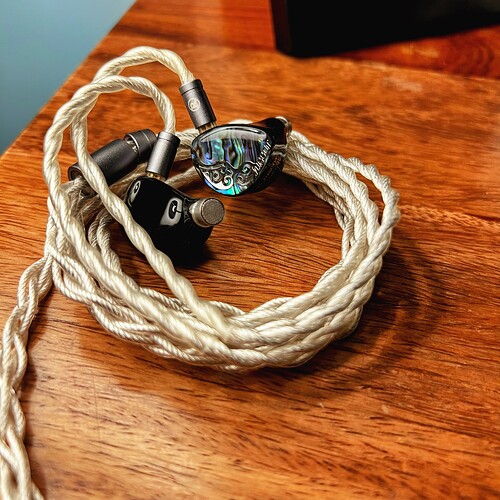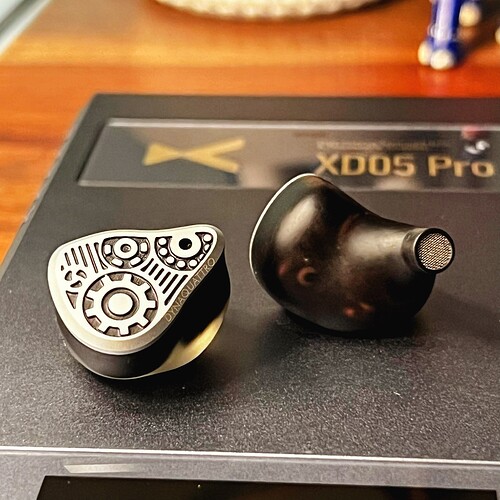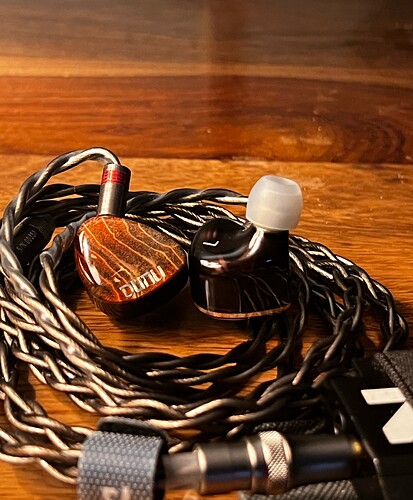A/Bing these two today and so far DynaQuattro is winning.
Agreed man
Dynaquattro>>Davinci>61t
That is all ![]()
Thanks @Jaytiss
I see a list that includes Explorer, I give it a like.
Thanks for your kind words man!!
Here’s my review for DynaQuattro
Pros: Deep, impactful sub-bass
Warm, natural tone and timbre
Perfectly balanced mid-range. Not too forward or recessed.
Excellent instrument separation and layering
Comfortable fit with good passive isolation
Cons: Treble lacks sparkle and air (not a major con for me)
Requires more power to drive optimally
Stock cable retains a lot of memory
Sources used:
- xDuoo XD05 Pro (AKM / Rohm) (w/ SS3602 OpAmps)
- Dita Navigator
- D16 Taipan /+ PB5 Osprey
- Qudelix T-71
- RME ADI-2 Pro FS R
- iFi Go Pods
Introduction:
Binary Acoustics is a relatively newcomer to the audio scene. Their previous release, Gizaudio X Chopin, had a mixed response from the community. Presenting the DynaQuattro—an IEM that is definitely highly anticipated and promising to put a new high bar on what a multi-driver dynamic IEM can deliver.

Design of the IEM and Cable:
The DynaQuattro comes with an elegant, modern look, showing off its metallic faceplate with recessed gear design in conjunction with a translucent resin body. This adds a lot of class to the IEM and gives it a kind of premium ruggedness. The IEMs come with a modular cable system, which allows for easy switching between 3.5 mm single-ended and 4.4 mmbalanced terminations. The cable is quite robust and manageable by itself but could be slightly softer to give more flexibility to the body and feel. The cable however retains a lot of memory making it impossible to keep in place, nice and tucked when folded.




It also comes with a pelican-type hard plastic case that ensures your IEMs will be very well protected while traveling.

Fit and Comfort:
It’s pretty amazing how the DynaQuattro has four dynamic drivers inside it, yet it is still comfortable in fit. The larger form factor may be a concern for few, but rest assured that the fit inside the ear is comfortable for long listening periods. The IEMs provide a great seal, offering extraordinary passive noise isolation, hence an increase in the listening experience while out and about as well.

Sound:
Sub Bass:
The DynaQuattro’s sub-bass performance is one of its stand-out features. Extension is really deep, giving a rumble that is as satisfying as it is impactful. This is very enjoyable with genres that center around sub-bass, such as EDM and hip-hop. The bass is so well-controlled that it doesn’t bleed into the mid-bass or muddy up the general sound signature.
Mid Bass:
The mid-bass in this piece is just punchy and dynamic, adding a good layer of warmth to the sound. It has enough presence to make bass-heavy tracks enjoyable without overpowering the mids. The well-defined bass notes provide a good texture and separation that keeps the sound clean and engaging.
Midrange:
The midrange of the DynaQuattro is slightly recessed however I felt that it was perfect. Not too forward or recessed. It does remain clear and detailed with a natural tonality that presents vocals and instruments sounding really lifelike. The transparency within the mids makes sure that both male and female vocals are portrayed accurately, although the upper mids will tend to be a bit forward for some listeners, and sometimes they can portray some female vocals as slightly aggressive.
Treble:
Treble on the DynaQuattro is smooth and non-fatiguing. It doesn’t have too much sparkle and air that some treble-heads may crave, but this makes it a great choice for those who are treble-sensitive. The treble extension is quite good here and is detailed enough to provide clarity without any hints of sibilance or harshness to bring out the nuances in the music.
Tone and Timbre:
The overall tone of the DynaQuattro is every so slightly warm and natural, typical for a properly tuned dynamic driver. The timbre is pretty realistic, making instruments sound legit. This makes DynaQuattro an IEM that’s well-made for any genre.
Staging, Instrument Separation and Layering:
It is moderately wide with good spacing and positioning. This will not be the widest soundstage for its price but it does offer a very nice holographic experience, especially for gaming and some of those nicely produced immersive tracks. Instrument separation and layering is good. Each element in the mix is clearly audible without it sounding cluttered.
Detail Retrieval:
The detail retrieval on the DynaQuattro is impressive, capturing micro-details that enhance the overall listening experience. It may not reach the extent of the resolution possessed by high-end multi-BA or planar IEMs, but still—this dynamic setup holds up very well, making it a really strong contender inside this price bracket.
Comparisons:
DynaQuattro vs Juzear 61T:
At the price point of the Juzear 61T, we find the treble to be tuned a little more balanced; it does represent a slightly more coherent treble extension with better details. Overall, the bass in DynaQuattro is greater in quantity and also tight and controlled, hence providing the sound with more punch and energy overall. If you’re looking for an IEM that sounds warm, natural, and also provides great weight at the low end, DynaQuattro is going to be for you. For those who are after a more neutral sound signature, with their treble having more finesse and sophistication to it, then the 61T may get the upper hand.
Please do note that I had a hard time listening to 61Tfor extended period of time due to the occlusion effect. The pressure inside the ears builds up fairly quickly and can become difficult to keep them on after 30mins or so. Wide bore tips were a better fit for 61T in my experience.

DynaQuattro vs Dunu x GizAudio DaVinci:
The DaVinci is, indeed, a really good IEM both in its technicalities and timbre. It has a more open and wider soundstage and more accurate mid range than the DynaQuattro and better imaging. On the contrary, the DynaQuattro has more body and more engaging bass punches and the treble has better extension compared to the DaVinci. So, for the more bassy genres, the DaVinci will do better. I felt the bass quantity on the DaVinci was a little too much for my liking but DynaQuattro was just perfect.
The choice between the two will vastly depend on what kind of sound signature you prefer and what genre of music you would like to listen to with the headphone.
Conclusion:
The Binary Acoustics DynaQuattro in the IEM world offers such a strong setup, considering its unique, four-dynamic-driver setup, which delivers a warm, natural sound coupled with great bass performance. It aligns really well with my preferences as it does put together quite a compelling package of sound quality, build, and comfort.

I’m looking forward to getting a unit for myself
Do you consider this as a hard to drive? I’m assuming so due to the driver configuration
Umm, I wouldn’t call it hard to drive as such but it does benefit from more power.
DynaQuattro vs Juzear 61T:
At the price point of the Juzear 61T, the treble is tuned more balanced and has a slightly more coherent treble extension with better details. In comparison, the DynaQuattro’s bass is greater in quantity and also tight and controlled, providing the sound with more punch and energy overall. If you’re looking for an IEM that sounds warm, natural, and offers great weight at the low end, the DynaQuattro is for you. For those seeking a more neutral sound signature, with their treble having more finesse and sophistication, the 61T might have the upper hand.
Bass: The DynaQuattro excels in the bass department, with its quantity and tight control delivering more punch and energy. It offers a deep, impactful bass with excellent slam and texture. This makes it highly enjoyable for genres that benefit from a strong low end. The 61T, on the other hand, provides a more balanced bass response. While it doesn’t deliver the same visceral impact as the DynaQuattro, it integrates well with the rest of the frequency range, maintaining a more neutral presentation.
Mid-Range: In the mid-range, the DynaQuattro has a more not too recessed and not too forward presentation and its detailed. Vocals and instruments are more prominent and clear, making it ideal for listeners who enjoy a mid-range-centric sound. The 61Tpresents a slightly warmer mid-range, with male vocals and instruments sounding fuller and richer. This warmth adds a pleasant tonality but might not have the same level of clarity and separation as the DynaQuattro.
Treble: The treble on the 61T is refined and sophisticated, with good extension and detail retrieval. It provides a smooth, coherent treble experience that enhances the overall neutrality of the IEM. The DynaQuattro’s treble, while also detailed and clear, lacks a bit of the airiness that the 61T provides. However, it still offers a high level of clarity and avoids sibilance, making it very pleasant for extended listening sessions.
Detail Retrieval: Both IEMs excel in detail retrieval, but they do so in different ways. The DynaQuattro’s almost perfect mid-range and impactful bass bring out micro-details in vocals and instruments that might be more subtle on the 61T. The 61T, with its balanced tuning and refined treble, captures the nuances in the upper frequencies better, making it excellent for intricate, high-frequency details.
Soundstage and Imaging: In terms of soundstage, the DynaQuattro offers a more immersive experience with a larger, more enveloping stage. Its imaging is precise, allowing for clear placement of instruments and vocals within the soundscape. The 61T has a more intimate soundstage, providing a closer, more personal listening experience. Its imaging is also accurate but might not feel as expansive as the DynaQuattro.
Thanks for sharing
Nice congratulations great set!
Thanks, till now - Loving it
Congratulations!! I loved the DynaQuattro. Do share your impressions.
Will do from tomorrow. So far loving the set
Cross posting this
61T vs DaVinci vs DynaQuattro:
Sub Bass
61T : The sub-bass is robust and provides a solid foundation, with ample energy that doesn’t overshadow the rest of the mix. It offers good extension and dynamics, making it suitable for genres that benefit from a strong low-end presence.
DaVinci: The DaVinci also delivers significant sub-bass, but it tends to have a more pronounced thud rather than a deep rumble. This characteristic can sometimes dominate the overall sound profile, especially in bass-heavy tracks.
DynaQuattro: The DynaQuattro offers an exceptionally deep and textured sub-bass, characterized by a rich, meaty presence. It strikes a balance between providing impactful bass without overwhelming the other frequencies, making it ideal for a variety of genres.
Order of my pick for Sub Bass:
DynaQuattro > 61T > DaVinci
Mid Bass
61T : The mid-bass is impactful and adds weight to kick drums and other percussive elements. However, it can sometimes bleed into the lower mid-range, slightly veiling details.
DaVinci: The mid-bass on the DaVinci is tighter and more controlled, providing a punchy experience without significant smearing. It manages to keep the bass presence strong without overwhelming the mid-range.
DynaQuattro: The DynaQuattro’s mid-bass is well-controlled and delivers excellent slam and impact. Its dynamic drivers ensure that the mid-bass remains tight and detailed, avoiding any unwanted bleed into the lower mid-range.
Order of my pick for Mid Bass:
DynaQuattro > DaVinci > 61T
Lower Mid Range
61T : The lower mid-range benefits from the added warmth of the mid-bass, providing a rich and full-bodied sound. However, the slight bass bleed can affect detail retrieval in this region.
DaVinci: The DaVinci’s lower mid-range is cleaner and more neutral. It avoids the bass bleed issue, resulting in clearer and more detailed mid-range performance.
DynaQuattro: The DynaQuattro offers a flat and natural lower mid-range, ensuring that male vocals and instruments sound realistic and well-defined. The transition from bass to mid-range is smooth, maintaining clarity and detail.
Order of my pick for Lower Mid Range:
DynaQuattro > DaVinci > 61T
Upper Mid Range
61T : The upper mid-range is well-tuned to ensure vocals have enough energy without becoming shouty. This contributes to a pleasant and engaging vocal presentation.
DaVinci: The DaVinci excels in the upper mid-range, offering a beautifully natural and refined sound. Vocals and instruments in this range are rendered with exceptional clarity and realism.
DynaQuattro: The DynaQuattro shines in the upper mid-range, offering a forward and detailed presentation. Vocals and instruments are highlighted without sounding shouty, making it ideal for vocal-centric genres.
Order of my pick for Upper Mid Range:
DaVinci > DynaQuattro > 61T
Lower Treble
61T : The lower treble is energetic but controlled, ensuring that higher-pitched instruments and cymbals have a good presence without becoming overly bright or fatiguing.
Dunu DaVinci: The lower treble on the DaVinci can come across as slightly dry and scratchy, though this can be mitigated with tip rolling. It maintains a good balance but isn’t as smooth as some might prefer.
DynaQuattro : The lower treble on the DynaQuattro is detailed and clear, offering a good balance between energy and smoothness. It avoids harshness and sibilance, providing a pleasant listening experience for higher-pitched instruments and cymbals.
Order of my pick for Lower Treble:
61T > DynaQuattro > DaVinci
Upper Treble
61T : The upper treble extends well, providing air and shimmer to the sound. It reveals fine details and contributes to a sense of openness.
DaVinci: The upper treble is somewhat relaxed but still provides good detail. It avoids harshness, but the overall treble timbre might not be as refined as 61T.
DynaQuattro: The DynaQuattro offers a balanced upper treble which is detailed enough to provide clarity without any hints of sibilance or harshness. It does however sometimes leave you wanting some sparkle and air.
Order of my pick for Upper Treble:
61T > DynaQuattro > DaVinci
Timbre
61T : Timbre is generally natural, though there are slight compromises due to the bass bleed into the mid-range. Instruments and vocals sound realistic, but not as transparent as DaVinci.
DaVinci: The DaVinci offers a more natural and cohesive timbre, with instruments and vocals sounding lifelike. Its balanced armature drivers contribute to a more refined and accurate representation.
DynaQuattro: The DynaQuattro excels in timbre, offering a highly natural and realistic sound. The use of dynamic drivers ensures that instruments and vocals sound authentic and lifelike, making it a standout in this category.
Order of my pick for Timbre:
DynaQuattro > DaVinci > 61T
Staging
61T : The soundstage is wide and provides a good sense of space, making it feel expansive. Instrument placement is mostly accurate, giving a solid sense of where each sound is coming from, though it may not be as immersive as DynaQuattro.
DaVinci: The DaVinci’s soundstage, while slightly more intimate, does well in imaging and separation. It provides a three-dimensional feel, allowing listeners to pinpoint the exact location of instruments and vocals within the sound field. This creates a more immersive listening experience.
DynaQuattro: The DynaQuattro offers a wide and expansive soundstage with excellent depth. It provides a spacious listening experience, with precise imaging and separation that allows for an immersive and engaging sound.
Order of my pick for Staging:
DynaQuattro > 61T > DaVinci
Instrument Separation and Layering
61T : Instrument separation is very good, especially for its price point. The multiple drivers help in achieving clear delineation between different sounds, though the slight bass bleed can occasionally muddy the lower mids.
DaVinci: The DaVinci excels in instrument separation and layering. Each instrument is clearly defined, and the layering provides a sense of depth that enhances the overall listening experience.
DynaQuattro: The DynaQuattro offers exceptional instrument separation and layering, with each sound distinctly placed within the soundstage. The use of four dynamic drivers ensures that complex tracks are handled with ease, providing clarity and depth.
Order of my pick for Separation and Layering:
DynaQuattro > 61T > DaVinci
Detail Retrieval
61T : Detail retrieval is strong, particularly in the treble and upper mid-range. However, the bass bleed into the lower mid-range can obscure some finer details, making it less transparent compared to higher-end models.
DaVinci: The DaVinci offers exceptional clarity in the mid range however falls short in the micro details compared to DynaQuattro and 61T due to the extremely tamed treble.
DynaQuattro: The DynaQuattro does really well in detail retrieval, offering a good level of clarity and precision across all frequencies. Its ability to capture micro-details and nuances makes it a top performer across all genres of music despite it not having the best extension like 61T.
Order of my pick for Detail Retrieval:
Subjective : DynaQuattro > 61T > DaVinci
Objective : 61T > DynaQuattro > DaVinci
Conclusion
All three IEMs—Juzear 61T, Dunu DaVinci, and Binary Acoustic DynaQuattro have few similarities but cater to different listening preferences and price points.
Juzear 61T: Priced around $220, it offers a robust and dynamic sound with a U-shaped signature emphasizing sub-bass and treble. While it excels in providing a wide soundstage and good instrument separation, it does have some issues with bass bleed affecting mid-range detail. It’s a strong contender in the sub-$300 category, particularly for those who enjoy a bass-forward sound.
Dunu DaVinci: At $300, the DaVinci delivers a more refined and balanced sound with a lot of focus on Sub-bass. It does well in imaging, instrument separation, and detail retrieval, though its bass dominance can sometimes crowd out the details. The treble timbre might require some tip rolling to optimize, but overall, it offers a decent level of technical performance. This IEM is ideal for those who prioritize a natural and cohesive sound with excellent clarity and realism.
Binary Acoustic DynaQuattro: The DynaQuattro, priced around $260, stands out with its use of four dynamic drivers, offering a rich, meaty bass, natural timbre, and expansive soundstage. It provides excellent detail retrieval and instrument separation, making it suitable for a wide range of music genres. This IEM is perfect for listeners who prefer a balanced yet engaging sound with a forward mid-range and detailed treble.
superb comparison
Thanks for sharing! The DQ sounds like a clear winner for my preferences. Would consider it if I didn’t already have the TSMR-X.
Hey, you all.
This IEM just scales and scales. It drastically changed when I switched over to PA10 from Dawn Pro




